2cm Flak 38 auf Selbstfahrlafette Zgkw.3t (Sd Kfz.11)
 Germany (1943) - FLAK half track - 605-644 converted
Germany (1943) - FLAK half track - 605-644 converted
About the Sd.Kfz.11
The second light prime mover half-track of the Wehrmacht was mostly designed as an ammunitions carrier, for towing various artillery pieces, including the 10.5 cm Field Howitzer, PAK-40, but also in time, all three Nebelfwerfer roket launchers, a task in which specialized units were created. The 9,000 vehicles produced mostly by Hanomag soldiered on all fronts during the war. It was declined in five major specialized variants, including three chemical warfare vehicles, and two specialized ammunitions carriers, with various bodies, including a 11-infantry seating variant, and a wartime simplified variant. The base ladder chassis was used for the shortened SdKfz 250 while it also spun the main APC of the Wehrmacht, the SdKfz 251. This underline the importance of this excellent chassis. The only known armored, main weapon carrier (self-propelled) was the Selbstfahrlafette (Sd.Kfz.11/1) für 2 cm Flak 38 auf le.Zgkw.3 t mit Panzerschutz, also called Sd.Kfz.11/1 (neue). It was not, contrary to the appearance, a derivative of the Sd.Kfz 251 D, even many sources wrongly calling it the Sd. Kfz. 251/17 in the literature.Design & Development
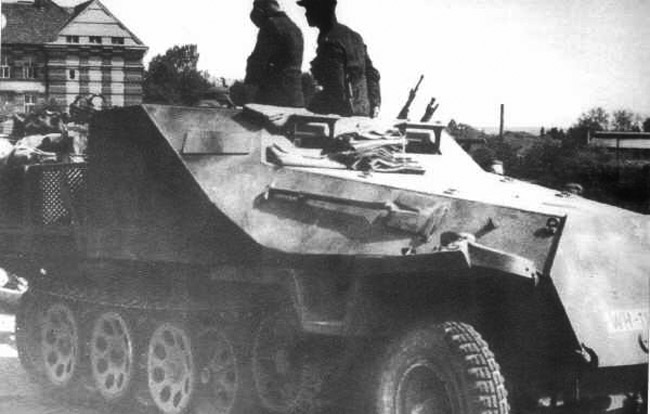
In the fall of 1943 and early 1944, an anti-aircraft modification was performed on the chassis of the H kl 6p, half-track 3 tons, also used for the Sd.Kfz.251. Since 1943 under Spee management, there was a concerted effort to unify platforms, and using the Hkl 6p seemed a good, cost-effective basis. A growing pressing need for organic anti-aircraft defense for German armoured units as the war progressed in 1944, trigerred by the gradual loss of air supremacy over the multiple theaters of Europe, led to devise a growing number of self-propelled FLAK vehicles, which gradually took more importance and even take part in close support ground combat. A request was done by the OKH to equip the rather universal SdKfz 11 chassis with a FLAK 38 2 cm rapid fire AA gun for that purpose. Previously the Panzer-I had been so equipped, as well as the SdKfz 10, little brother of the model 11.
The task went to Horch, beginning with a prototype presented in March 1944. The frontal part of the vehicle was armoured, but not the rear open bed, on which was mounted the FLAK ordnance. The armour shape was roughly similar to the Sd.Kfz.251 D, leading some authors to call it the Sd. Kfz. 251/17, but it was never official. Instead the vehicle is assimilated to the SdKfz 11/1, which is confusing as the latter was an early ammunition carrier, for the 10 cm Nebelwerfer 35/40 mortar. Compartment's racks were specific to hold the shells and propellant, with side-opening doors.
Detail is lacking on this, but it's likely these vehicles were gradually withdrawn from active service and converted as the new armored FLAK carrier. Although not official either, a distinction could be made between the "alte" ad "neue" models. There is no precise record about what types of chassis were called for conversion and it could have been diverse, also including chemical warfare variants, quickly obsolete. The other explanation generally given in German sources about the designations was that it was simply newly assigned because production of the previous Nebelkraftwagen Sd.Kfz.11/1 was expired, its task now taken by the Nebelkraftwagen Sd.Kfz.11/5. There is so hardly any technical link between the two versions. The vehicle converted were likely the 1944 version of the SdKfz 11.
Technical description
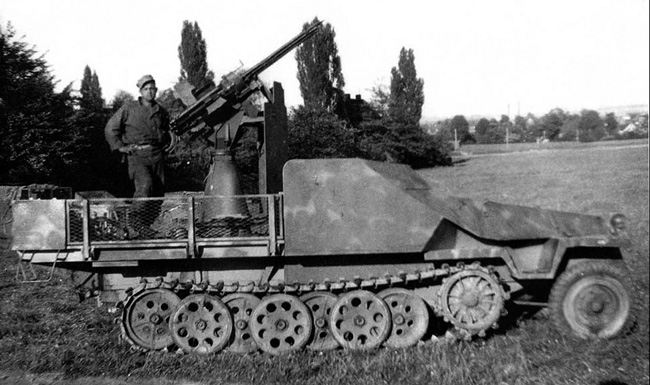
The chassis and engine were entirely the same as the basic SdKfz 11. It used the same ladder frame, with the Schachtellaufwerk system (interleawed wheels) for the tracks, and front axle, which could be combined for tighter turns. The H kl 6. was given in 1944 the HL 42 TUKRM engine from Maybach, and Hanomag's four-speed U 50 transmission. It had a 110 litres (29 US gal) fuel tank, the whole reaching 7,200 kilograms (15,900 lb). It was however capable of carrying a payload of 1,800 kilograms (4,000 lb) at the rear, which about the weight of the FLAK 38 20 mm gun and its mount. However, with the addition of the armour, the the vehicle, fully laden and battle ready reached 8,10 tons (17,857 lb), with 900 kgs (1984 Ibs) of armor.
Its overall Length was 19ft 0,34in (5.8 m), Width 7ft 6,54in (2.20 m) and overall height 5ft 10,87in (1.55 m), with a ground clearance of 1ft 0,59in (31 cm) and can ford 19.7 inches of water (50 cm). The design scheme of the armor, was sensibly different than of the SdKfz 250 although quite obviously inspired by it: The radiator was protected by aplate, as the prismatic hood, and cab, plus two side plates with an open space behind the drive and co-driver where the 3-4 crew seated. The vehicle depending on sources had either five or six onboard. The FLAK gun ideally only needed 3, less an officer. There were two armored folding shutters at the front, and two sliding ones on the sides. Access was made from the rear of the cab as there were no doors.
The armored body was made of sloped 8 mm steel plates for the sides, and 15 mm at the front enough to protect against shrapnel and infantry fire, even light cannons or heavy machine guns AP rounds. The flatbed was however entirely open and unprotected. The grid barriers would be lowered down to create a large platform for the gun operators to move around. Ammunition boxes were stored at the rear of the platform in two stowage bins overhanging the rear if the chassis.
The gun: 2 cm FLAK 38
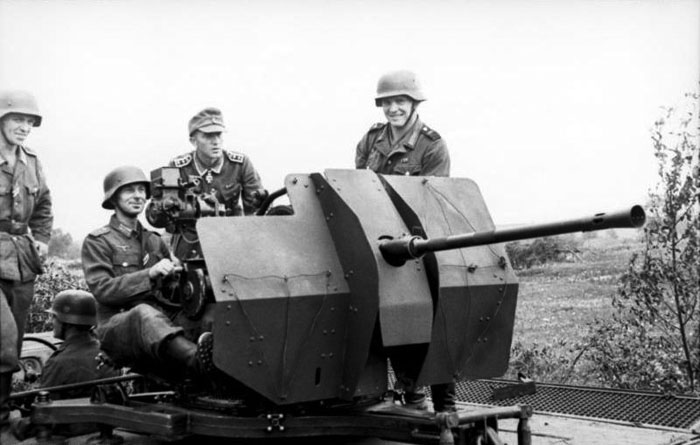
The Mauser Flakvierling 38 derived from the 1934 FLAK 30, originally derived from the Swiss Solothurn, itself based on a WWI German heavy machine gun project. The Kriegsmarine 20 mm C/30 was developed from the ST-5. It was riddled with jamming issues despite an outstanding 120 rpm. It was eventually adopted in 1939 both the Heer and Kriegsmarine, the first calling it the 2 cm Flak 38.
Over 40,000+ of the latter type were produced in WW2, going into many vehicles conversions. This very dependable ordnance weighted 405 kg (893 lb), for a length of 4.08 m (13 ft 5 in), a barrel length of 1.3 m (4 ft 3 in) for the L/65, 1.81 m (5 ft 11 in) wide for 1.6 m (5 ft 3 in) high. It was protected by a prismatic shield with folding panels. It needed a crew of 5, fired a 20×138mmB HE/Tracer shell, had an elevation of -12°to ±90° and a 360° traverse.
Rate of fire was 450 rpm (cyclic)/180 rpm (practical), with a muzzle velocity of 900 m/s (2,953 ft/s) and effective firing range of 2,200 m (2,406 yds) in anti-aircraft role at max elevation, and on ground targets, up to 5,783 m (5,230 yds). Like the Bofors, its standard loading mode, manual, included 20 round box magazine, which needed two loaders, two pointers and a commander.
Performances FLAK 38Penetration of a shielding plate (mm) under a plunging angle of 30° | |||||
| Ammo | Weight | Velocity | 100 m | 500 m | 100 m |
| PzGr | 0.148 kg | 780 m/s | 20 | 14 | 9 |
| PzGr 40 | 0.1 kg | 1050 m/s | 49 | 20 | - |
Production
After the Horch prototype was accepted by the waffenamt in February 1944. The production contract was won by Auto Union Chemnitz (contract no. - 4911-021300306/42), for 2,400 machines. Production was to be carried out at the main Horch facility in Zwickau. The first five production machines were completed in March 1944. By the fall of February 1945, 604 were produced while there were plans to furtjer streamling producton to reach 50 vehicles a month, but records were not preserved.Production at Auto-Union AG in Chemnitz, also responsible for the conversion proceeded by using the naked chassis from Hanomag, welded the armored cab at the front, fitting a flatbed with anti-slip plating and grid barriers, ammunition boxes, and the main structure for the Flakvierling 38 manufactured by Rheinmetall. At that stage, the vehicles were likely paintined in standard dunkelgelb, to be later camouflage-painted on the front. Some could have been painted also in feldgrau, based on remaining paint stocks only.
Production records differed: Some sources states 605, other 644. Differences could result from new construction and conversions mixup. Indeed damage chassis from SdKfz 11 half tracks would have been used rather than newly built ones. This model was well-liked by its crews as it provided a better protection than the Sd.Kfz.10/4 FLAK 30 and 2cm FLAK 38 auf Selbfahrlakette Sd.Kfz.10/5, the "Gepanzerte" variants having just a simple paneling around the driver.
Combat use
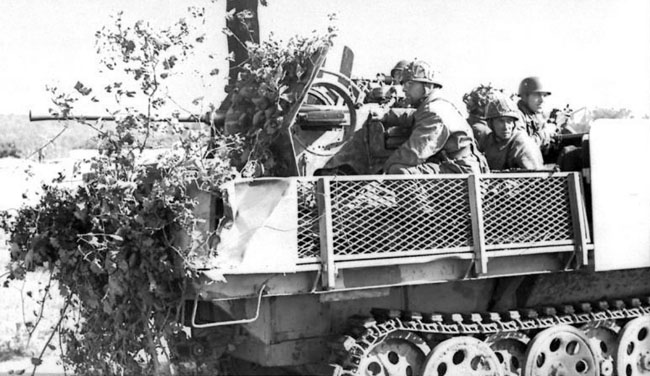
The vehicle in Arhnem, camouflaged (CC photo, wikimedia commons)
The Sd. Kfz. 11/1 was sometimes used without the 2 cm Flak 38 as partly armoured transportation vehicle. 644 vehicles were manufactured by end of March 1945 according to almost all sources. Rejected vehicles indeed not used as ammunition/supply vehicles were converted for other tasks, with the possibility of mounting the FLAK 38 preserved. Precise records are unclear but photos gives a clue.
The vehicle was seemingly used in Normandy from June 1944 in small numbers. One shows a vehicle in Operation Market Garden, in Arneim. Many were lost during the escape of the Falaise Pocket in August, others were fighting in Paris according to a single photo (which are rare by the way).
Others were supposed to have fought in east prussia during Operation Bagration and during the long and protracted defence of Berlin (notably the Seelow Heights) until May 1945.

A conversion of the simplified, late SdKfz 11 into a self-propelled FLAK 38 carrier, unarmored (pinterest)
See also:
On kfzderwehrmacht.deprussia.online
war-book.ru
guerra-abierta.blogspot.com
On warthunder Forum
On armedconflicts.com
wiki - Sd.Kfz._11/1
HETLER, N. “Leichter Zugkraftwagen 3 ton and variants Hanomag/Borgward Sd.Kfz. 11” 2007
LEDWOCH, J. “Zgkw 3t Sd Kfz 11” Wydawnictwo Militaria
Thomas L. Jentz, Hillary Louis Doyle : Flak Selbstfahrlaffeten and Flakpanzers - SdKfz.10/4 to 8,8cm Flak auf WFW (Panzer Tracts 12) Darlington Prod. inc.
Niehorster, Leo WG Duitse Tweede Wereldoorlog Organizational Series, Vol. 4/II: Gemechaniseerde GHQ-eenheden en Waffen-SS-formaties (28 juni 1942) Milton Keyes, Buckinghamshire: Military Press, 2004
Spielberger, Walter J. Halfrupsvoertuigen van het Duitse leger 1909-1945 . Atlgen, PA: Schiffer, 2008 ISBN 978-0-7643-2942-5
Hanomag Sd.Kfz.11/1 (late) specifications | |
| Dimensions | 5.8 x 2.2 x 1.8 m (xxx ft) |
| Total weight, battle ready | kg 8.1 to 11 tons in battle order |
| Crew | 6 (driver+ 5 gun crew |
| Propulsion | Maybach 6-cyl HL42 100 hp/2800 rpm 4.2 cm3 |
| Top speed | 33-53 km/h on road |
| Transmission & suspension | 4+1 speed U50 - leaf springs, torsion bars |
| Maximum range | 250 km road, 100 km off-road. |
| Armament | 76.2 mm F22 gun |
| Armor | 8 to 15 mm (0.3-0.6 in) |
| Conversions/Constructions | 644 |
Gallery
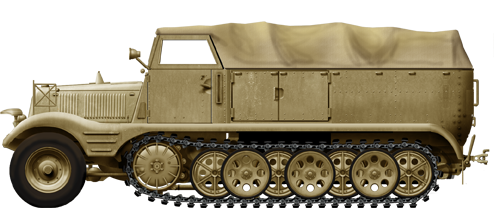
Basic Sd/Kfz.11 carrier
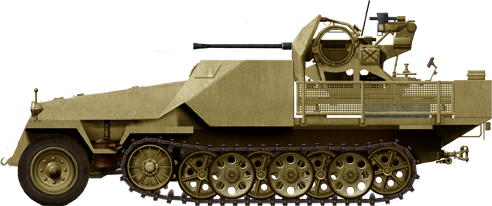
Vehicle in base sand livery, fresh from the factory
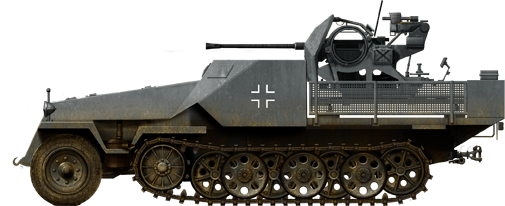
Vehicle in Fedldgrau livery. A B&W photo shows indeed a very dark vehicle, likely to have been painted in that color based on old stocks.
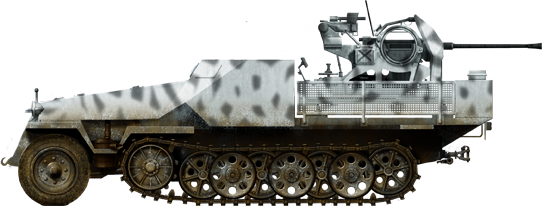
Winter camouflage 1944-45
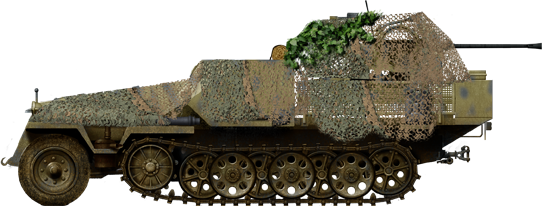
Another camouflaged vehicle in 1945

Vehicle fighting in Arnheim

Photo coll. Fort Knox, USA.
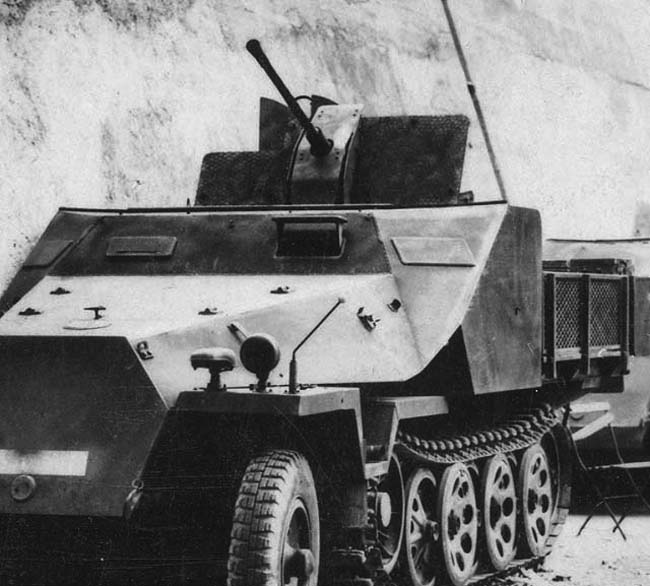
Luxemburg Gardens, closeup


WW2 Tanks




























WW2 tanks posters

All Tiger tanks liveries.

Panther liveries and variants

WW2 Armour - All tanks











Tanks aces and single tanks series

Find more there

Museums, Movies, Books & Games
The Tanks and Armor in pop culture
Tanks and armored vehicles in general are only really grasped when seen first person: The mass, the scale, it's all there. Explore also the way tanks were covered in the movie industry, in books and in video games.Movies:
Best tanks movie on warhistoryonline.com
On imdb.com
On bestsimilar.com/
miltours.com
liveabout.com/
watchmojo.com
Video Games:
pcgamesn.com
historyhit.com
levvvel.com
vg247.com/best-tank-games
mmobomb.com/
alienwarearena.com
